The Noreaster oil tanker in port today at Sprague Energy’s East Providence terminal. Another example of our working waterfront providing the energy resources that power Rhode Island and the wider region’s economy.
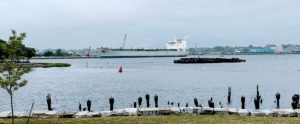
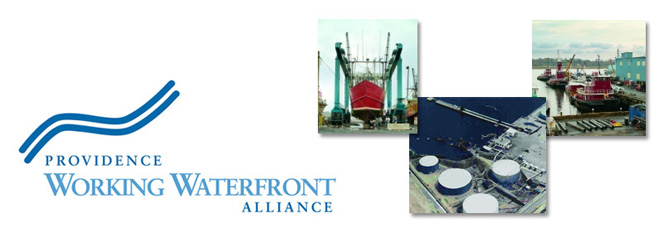
The Noreaster oil tanker in port today at Sprague Energy’s East Providence terminal. Another example of our working waterfront providing the energy resources that power Rhode Island and the wider region’s economy.

A beautiful sunrise over Providence Harbor with two Providence Steamboat tugs assisting a ship into port (at left).
Ready for winter? Thanks to road salt and home heating oil at Sprague Energy’s Allens Ave terminal, Rhode Island has the resources to weather the cold, ice, and snow that’s just around the corner. Another example of Providence’s working waterfront powering our region’s economy.
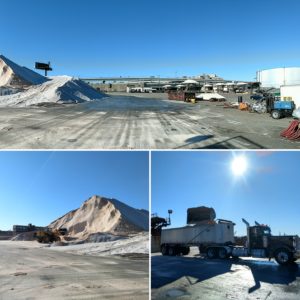

A bulk carrier in port last week loading scrap at Sims Metal Management’s Providence Export Facility.
Last night, members of the Providence Working Waterfront Alliance testified before the House Committee on Finance in strong support of Budget Article 16, Section 4 which would appropriate $10.5 million for the construction of a new Confined Aquatic Disposal (CAD) Cell critical to the upcoming maintenance dredging of the Providence River and Harbor Shipping Channel.
Providence’s water-dependent terminals and nearby industrial businesses generate hundreds of millions of dollars in total economic impact, supply the region’s energy, provide hundreds of good paying blue collar jobs, and thousands more related jobs. The majority of this economic activity is directly facilitated by Providence Harbor’s 40 foot deep-water channel. The channel was last dredged in 2003 and maintenance dredging will be required in the near future to protect this critical infrastructure asset for our state.
Appropriating $10.5 million for the construction of a new CAD cell to receive dredged sediments is a smart and necessary investment.
Read our full written testimony in support of Budget Article 16, Section 4 here.
Photographer Norma Smith stopped by earlier this week to snap a few shots of Providence Steamboat’s beautiful tugs.
Today’s Providence Journal features a beautiful photo section with pictures of Providence Harbor and our working waterfront. Pictured: Providence Steamboat Company and Sims Metal Management’s export terminal and ship repair yard (blue building in second picture).
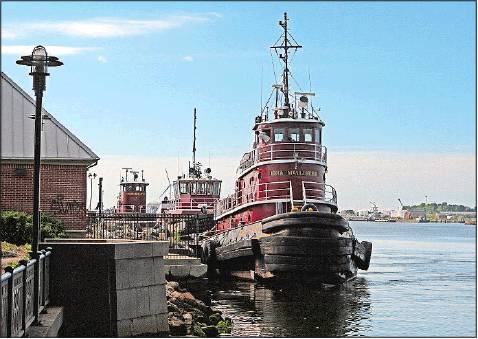
Photo Credit: Providence Journal / Steve Szydlowski
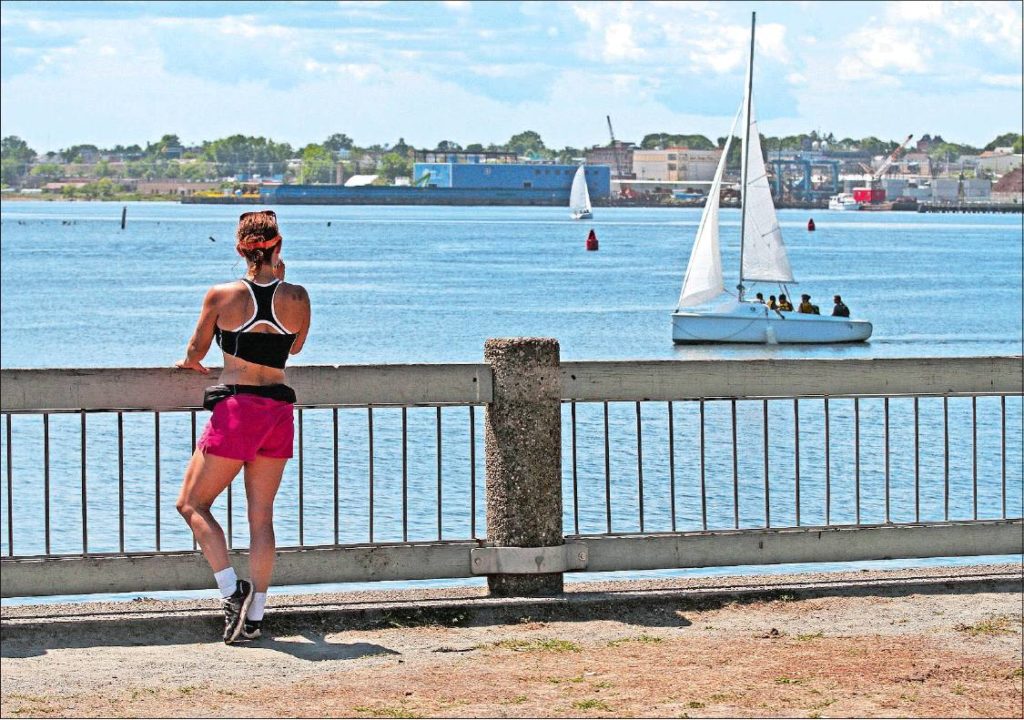
Photo Credit: Providence Journal / Steve Szydlowski
A view of the Allens Ave working waterfront circa 1957. The large coal piles adjacent to Sprague Energy’s terminal (right) supplied the Manchester Street power plant.
Providence’s working waterfront continues to supply Rhode Island and the wider region with critical energy supplies including home heating oil, gasoline, and jet fuel.
Watch Gavin Black of Providence-based Moran Shipping talk about Rhode Island’s commercial deepwater ports, a key economic asset for our state.
On a beautiful late summer day in September no one wants to think about a cold and icy New England winter ahead of us. But preparations are already under way, including a recent shipment of approximately 38,000 tons of road salt delivered to Sprague Energy’s Allens Avenue terminal. Another example of Providence’s working waterfront supplying critical resources for Rhode Island and the wider southern New England region.
Beautiful photo of Providence’s working waterfront 100+ years ago. A working port is part of the fabric of our great city.
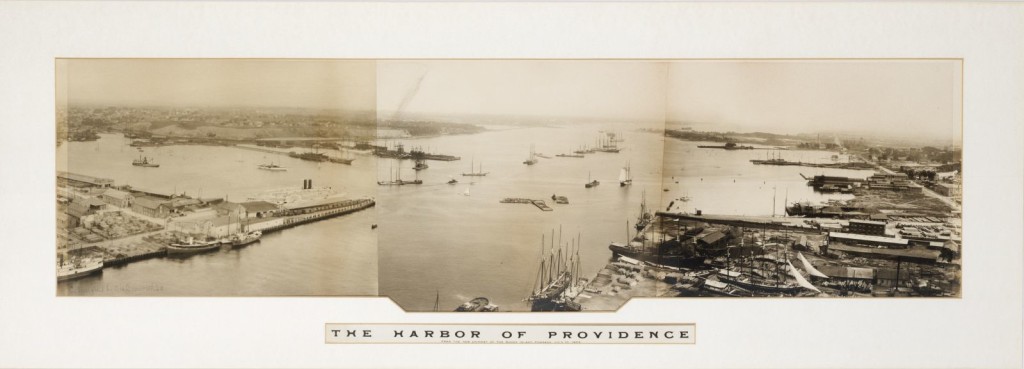
National Journal has an excellent article,”A Deep-Water Port’s Key Importance to New England’s Energy Fortunes“, on the importance of the Port of Providence to supplying Rhode Island and the wider region with the energy products and other resources that power our economy.
Around the clock, hulking oil tanker ships that appear too massive to float glide to a stop in the Port of Providence, R.I. Massive hoses suck fuel from the ships. After finely tuned processing that’s specific to its final use, the fuel is pumped into waiting trucks that quickly head off to myriad destinations around the region.
Everything involved in the operation seems larger than life and the coordination of moving pieces is seamless.
This week’s Providence Business News features a profile of Providence Working Waterfront Alliance member Sims Metal Management and their extensive metals recycling operation in Rhode Island.
Bill Huling, director of New England operations for Sims Metal Management, stepped back as another dump truck banged off the roll-on scales, reversed up to a three-story mound of broken metal chunks and, with the crash of a building collapse, dropped several additional tons at its foot.
Desolate-looking behind a security fence and the wall of scrap from the Allens Avenue pavement, Sims’ Providence harbor-front export terminal was reverberating with activity and the rattle of cascading iron on a frigid November Friday.
“They’re getting ready for the ship to come in,” Huling said, as a gust blew a mix of metal dust and marine-paint fumes at the workers attending to the scrap pile.
The ship was the Falcon Trader II, a 623-foot long Filipino-flagged freighter that would arrive two days later and spend the Thanksgiving holiday being stuffed by longshoremen with ferrous metal.

PBN PHOTO/MICHAEL SALERNO
The Providence Working Waterfront Alliance is strongly opposed to candidate Vincent Cianci’s so called “waterfront plan,” which is little more than a rehashing of the failed Narragansett Landing plan released by Mr. Cianci some 15 years ago. Put simply, this “plan” threatens hundreds of good paying blue collar jobs and over a thousand related jobs provided by water-dependent and industrial businesses along the Allens Avenue corridor in the Port of Providence. Hotels, condominiums, and recreational marinas are simply incompatible with the heavy industrial character of our neighborhood.
Mixed use means densely clustering compatible uses. It does not mean placing obviously conflicting uses directly next to each other. For example, locating a hotel or condominium directly in-between an oil terminal, an asphalt plant, and a major metals recycling export and marine repair facility. Hotel guests and/or residents would surely complain about the loud noises and 24-hour operations of directly adjacent industrial businesses. This in turn would lead to pressure to place restrictions on these businesses, thus threatening their ability to operate.
While the only “mixed use” project in the area went bankrupt in 2010, the industrial businesses on Allens Avenue have thrived and attracted tens of millions of dollars in investment. This has been made possible by the strong industrial zoning passed by the Providence City Council and signed into law by Mayor Angel Taveras in August.
Rather than threaten our area with clearly incompatible uses, Providence city government should work to promote, market, and grow our industrial working waterfront. A unique asset that supplies good paying blue collar jobs and the critical commodities that power our region’s economy.
In an editorial in Sunday’s paper, the Providence Journal praises Mayor Angel Taveras and the City Council for adopting strong zoning protections for Providence’s working waterfront and nearby industrial businesses.
Port with potential
One of the precious assets of Rhode Island, with a marvelous capacity to help our economy grow, is Providence’s deepwater port. Various schemes have been proposed to turn it into a playground for developers, something that would ludicrously squander its potential. But Providence leaders in recent days have taken some historic steps to make sure that does not happen.
Mayor Angel Taveras has signed into law an amendment to the city’s zoning ordinance to protect the waterfront as a working port, rather than permit it to be developed as condos, marinas and the like. Mr. Taveras, City Council President Michael Solomon and others worked hard to protect the working waterfront along the Allens Avenue corridor from the Hurricane Barrier to ProvPort.
“Hundreds of direct jobs and thousands of indirect jobs are based right here in the industrial waterfront of Providence,” the mayor said in a statement. “This amendment paves the way for the creation of more high-paying blue-collar jobs, brings the zoning ordinance into compliance with the city’s comprehensive plan, and sends a clear signal to companies worldwide that Providence is dedicated to supporting its industrial and working waterfront businesses.”
Many communities hungry for jobs would love to have the remarkable infrastructure that Providence has: a deep-water channel with rail and highway access. The port is responsible for an estimated hundreds of millions of dollars in total economic impact for the region. Each year, more than 2,000 ships unload such materials as salt (to keep our roads safe in winter), cement, asphalt and home heating oil, and load up with recycled metal for international markets. Some 9 million tons of cargo pass through the port annually.
And the future looks brighter. With the expansion of the Panama Canal permitting bigger vessels to pass through to Eastern ports, Providence is well positioned for perhaps dramatic growth. Meanwhile, all three of the leading Democratic candidates for mayor — Mr. Solomon, Jorge Elorza and Brett Smiley — recognize the importance of expanding the port’s business and creating more good-paying, blue-collar jobs, with thousands of related jobs (tradesmen, truck drivers, service technicians, and the like).
Under the zoning changes, residential, hotel and other mixed uses that are inappropriate for this heavy industrial area are now prohibited. That should give businesses the confidence to invest in the port area and grow. It is the port, after all, with its deepwater channel and industrial zoning, that inspired Sims Metal Management to invest $70 million locating its export facility on Allens Avenue with a shredder facility in Johnston. Look for more in the years ahead, particularly if the next Rhode Island governor moves aggressively with House Speaker Nicholas Mattiello to create a more robust economy.